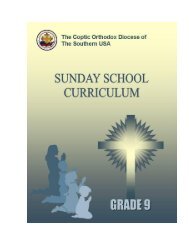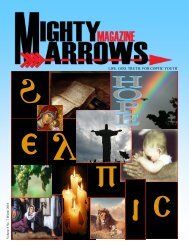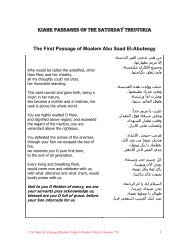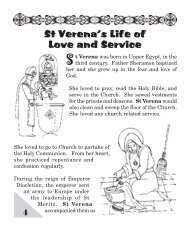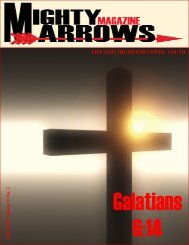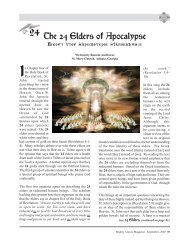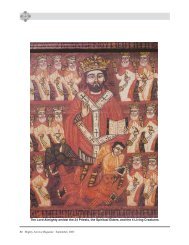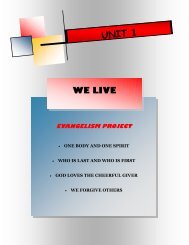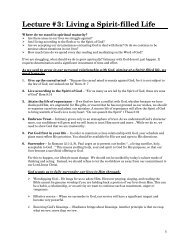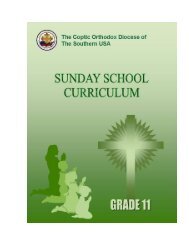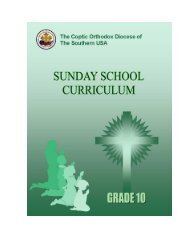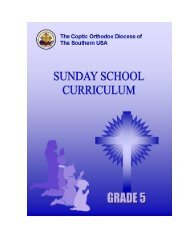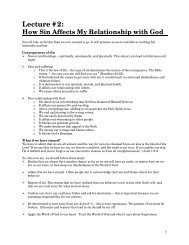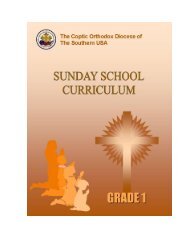Grade 12 - Coptic Orthodox Diocese of the Southern United States
Grade 12 - Coptic Orthodox Diocese of the Southern United States
Grade 12 - Coptic Orthodox Diocese of the Southern United States
You also want an ePaper? Increase the reach of your titles
YUMPU automatically turns print PDFs into web optimized ePapers that Google loves.
Sunday School Curriculum <strong>Grade</strong> <strong>12</strong><br />
The curtains were made <strong>of</strong> four kinds <strong>of</strong> material:<br />
a) Blue thread cloth (light blue) as a symbol <strong>of</strong> Christ‘s heavenly person since He is <strong>the</strong><br />
Son <strong>of</strong> God.<br />
a) Purple thread cloth (vivid red) to denote <strong>the</strong> King <strong>of</strong> Glory - purple is a royal color.<br />
b) Scarlet cloth (dark red) to denote Jesus who was wounded for us.<br />
c) White fine linen (twined) as a symbol <strong>of</strong> our Lord‘s nature – spotless and without sin -<br />
thus denoting our Redeemer.<br />
The curtains were hung up on four pillars made <strong>of</strong> acacia wood overlaid with gold. These<br />
stand for <strong>the</strong> love <strong>of</strong> Christ (God‘s Son Incarnated) and His redeeming <strong>of</strong>fering that<br />
encompasses and embraces <strong>the</strong> whole earth (<strong>the</strong> four corners): ―For God so loved <strong>the</strong> world,<br />
that He gave His only Begotten Son, that whoever believes in Him should not perish but have<br />
everlasting life” (John 3:16).<br />
B. The Bronze Altar (for Burnt Offering)<br />
This is what first meets a person entering <strong>the</strong> court and it lies on one line leading from <strong>the</strong><br />
door <strong>of</strong> <strong>the</strong> court into <strong>the</strong> tabernacle <strong>of</strong> meeting, <strong>the</strong>n into <strong>the</strong> holy place or sanctuary and into<br />
<strong>the</strong> most holy.<br />
The bronze altar is considered <strong>the</strong> biggest piece in <strong>the</strong> tabernacle <strong>of</strong> meeting. It was in <strong>the</strong><br />
form <strong>of</strong> a case that was five cubits long, five cubits wide, and three cubits high. It was made<br />
<strong>of</strong> acacia wood (resistant to wood worms) overlaid with bronze. It had four protruding horns<br />
on <strong>the</strong> four corners. The altar was hollow and this became filled with fuel and ashes <strong>of</strong> <strong>the</strong><br />
<strong>of</strong>ferings presented on it. The altar had two poles made <strong>of</strong> acacia wood and overlaid with<br />
bronze, which were passed through rings found in <strong>the</strong> grate network (a frame in <strong>the</strong> form <strong>of</strong> a<br />
net all around <strong>the</strong> altar). These poles were used to carry <strong>the</strong> altar.<br />
All <strong>the</strong> utensils used on this altar were made <strong>of</strong> bronze. The <strong>of</strong>ferings presented on it were <strong>of</strong><br />
various kinds. The fire was never put out so that it continually burned (Leviticus 6:9). The<br />
Lord started this fire on <strong>the</strong> day <strong>of</strong> its sanctification and it was <strong>the</strong> minister‘s job to add dry<br />
fuel only.<br />
The bronze altar and all <strong>the</strong> <strong>of</strong>ferings presented on it indicate Christ who suffered indictment<br />
on our behalf: ―But He was wounded for our transgressions, He was bruised for our<br />
iniquities; <strong>the</strong> chastisement for our peace was upon Him, and by His stripes we are healed”<br />
(Isaiah 53:5).<br />
The <strong>of</strong>fering presented had to be spotless - without blemish. The sinner had to place his hands<br />
on its head and confess his sins. Then, <strong>the</strong> priest would burn it all on <strong>the</strong> altar. It was <strong>the</strong><br />
promise God had made to forgive <strong>the</strong> sins <strong>of</strong> those who presented an <strong>of</strong>fering, ―sins are not<br />
forgiven without blood‖ (Hebrews 9:22). This promise <strong>of</strong> atonement and salvation are<br />
indicated by <strong>the</strong> horns <strong>of</strong> <strong>the</strong> altar, which stand for <strong>the</strong> power and efficacy <strong>of</strong> Christ‘s <strong>of</strong>fering.<br />
The horns also served as a means <strong>of</strong> salvation to all those who sought refuge in <strong>the</strong>m. There,<br />
<strong>the</strong>y could be safe until <strong>the</strong>ir innocence was confirmed.<br />
The <strong>of</strong>fering was tied to <strong>the</strong> horns <strong>of</strong> <strong>the</strong> altar before it was presented and burned. This<br />
symbolizes <strong>the</strong> tie <strong>of</strong> love, which made <strong>the</strong> Lord look towards Jerusalem and Golgotha.<br />
Although <strong>the</strong> <strong>of</strong>fering was considered a bearer <strong>of</strong> sin upon presenting it, yet God ordered that<br />
its ashes be ga<strong>the</strong>red in a pure pot. These were sprayed over sinners as means <strong>of</strong> purification<br />
(Numbers 19:9). St. Paul comments on this issue asking us to consider <strong>the</strong> efficacy <strong>of</strong> our<br />
OCTOBER 47



